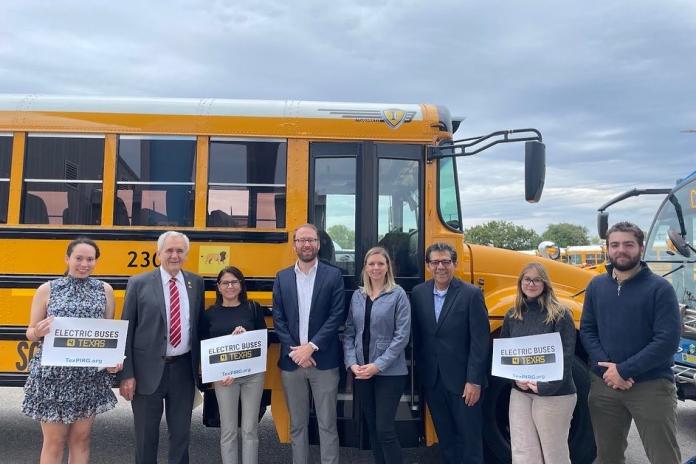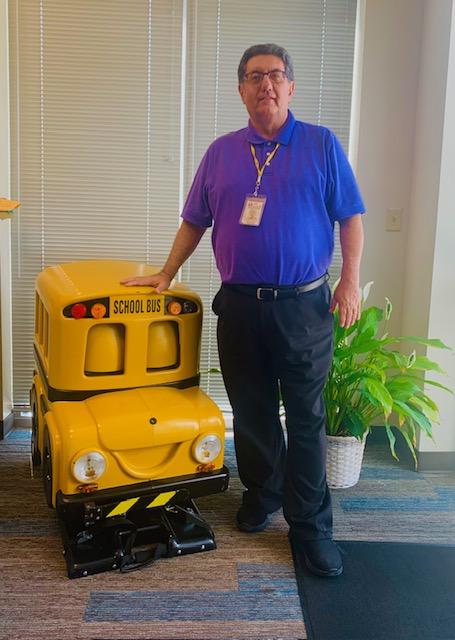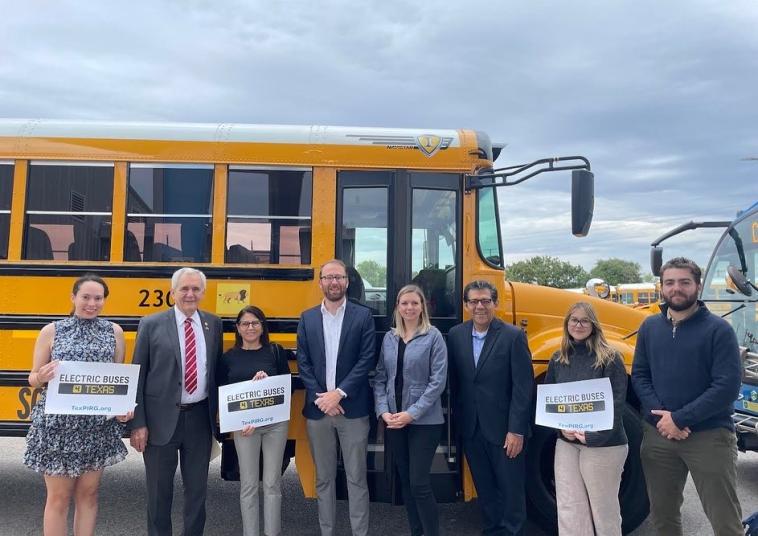How Austin's School Board Resolution Created a Path for Cleaner Rides for Kids

In collaboration with partners and communities, WRI’s Electric School Bus Initiative aims to build unstoppable momentum toward an equitable transition of the U.S. school bus fleet to electric by 2030, bringing health, climate and economic benefits to children and families across the country and normalizing electric mobility for an entire generation. The Electric School Bus Series shows how superintendents and fleet managers have pursued school bus electrification in their own communities. This edition features Austin Independent School District (Austin ISD) in Texas, whose board of trustees passed a resolution in September 2022 committing the school district to purchasing exclusively electric school buses by 2030 on the path to full fleet electrification by 2035.
This piece is based on interviews with Kris Hafezizadeh, Executive Director of Transportation & Vehicle Services for Austin ISD, and Luke Metzger, the Executive Director of Environment Texas.
Austin ISD is leading the charge as one of a growing number of school districts in the nation with a district-level goal to transition its entire school bus fleet to electric. Austin ISD has set a target of 2035, outlined in a resolution that the Austin ISD Board of Trustees passed in September 2022.
The Board passed the resolution approximately two months prior to an election in which Austin voters would select members of the board of trustees and vote on three propositions for the Austin ISD 2022 Bond, used to finance construction projects and capital improvements. In the run-up to the election, the trustees saw an electric school bus transition target as an opportunity to highlight and act on their commitment to student health and align themselves with city climate initiatives to achieve net-zero greenhouse gas emissions by 2040.
Capitalizing on the momentum of the upcoming election, the board of trustees crafted a bold yet achievable vision for the 550 buses that transport 23,000 students daily. Then, trustees unanimously passed the resolution to transition the entire fleet to electric by 2035 (with incremental new bus purchase targets of 25% by 2023, 50% by 2027 and 100% by 2030), setting the school district on its way to full electrification over the following 12 years.
In November 2022, this resolution got a financial boost with the passage of the $2.4 billion 2022 Bond, the largest in the city’s history, $25.7 million of which will go towards school bus replacement.
Motivation and Co-benefits
In their Climate Equity Plan, the city of Austin set a target for net-zero community-wide emissions by 2040. A core strategy for decarbonizing the transport sector is to electrify public sector fleet vehicles, including the transit system, Capital Metro (CapMetro) and school buses.
As Kris Hafezizadeh, Austin ISD’s Executive Director of Transportation & Vehicle Services, saw the city and transit agency going electric, he knew the district “wanted to be part of it.” The transportation department had a long history of exploring alternative fuels, beginning in 2007 with a plug-in hybrid bus, followed by seven propane buses. The district began exploring electrification around seven years ago and started conversations with Austin Energy early on to identify what that process would entail. In September 2022, Austin ISD ordered three electric school buses to pilot (see Implementation Status).
Like the transportation department, the trustees wanted to demonstrate that the district supports the Climate Equity Plan and respond to community concerns about harmful diesel pollution by prioritizing clean rides for students. After observing the experiences of school districts across the country and working locally with stakeholder groups, the trustees unanimously passed the resolution to transition the district’s fleet to all electric by 2035. The resolution cites improving student health by eliminating nitrous oxide (NOx) and particulate matter (PM) emissions, fuel and operating and maintenance cost savings, and the potential for vehicle-to-grid (V2G) as benefits of fleet electrification.

Partners, Advocates and Tactics
Throughout the process, myriad stakeholders contributed knowledge and expertise. The trustees worked closely with the district’s Transportation department to understand operational considerations, while groups like Environment Texas and their partners coordinated community support and public education opportunities on the benefits of electric school buses.
To build interest and a case for electric school buses, local advocates relied on several strategies to support the board of trustees. Two key strategies included:
- Educating Stakeholders and Providing Information, via Webinar: In October 2020, the Texas Electric Transportation Resources Alliance and Environment Texas co-hosted a webinar on the benefits of electric school buses. Panelists included Hafezizadeh, the Texas Public Interest Research Group (TexPIRG), the Environmental Defense Fund, the Electrification Coalition, and a mother and future pediatrician. Half a dozen school board trustees and candidates for trustees attended the webinar.
- Garnering Support, via Sign-on Letter: In August 2022, TexPIRG and Environment Texas organized a letter calling for Austin ISD to go beyond a pilot and commit to transition the full school bus fleet. Signatories included more than two dozen local, state and federal elected officials (including Mayor Steve Adler and U.S. Representative Lloyd Doggett); Parent Teacher Association (PTA) members; community members; and several environmental, health and community groups.
Through these efforts, advocates were able to shed light on the importance of embracing efforts to achieve cleaner air from a community perspective. Local call-to-action and desire to align with the city’s climate efforts impacted the Austin ISD trustees, who then assessed the feasibility by:
- Involving the Transportation Department: Throughout the process, Hafezizadeh’s team provided important information to trustees on the district's fleet operations. Reflecting on the meetings, Hafezizadeh said “involving transportation departments not only for this project but for anything that might impact student transportation,” is essential. He added, “It’s easy to say, ‘let’s do something,’ but there are tons of other logistics that transportation brings to the table to make a project successful.”
To better understand electric operations, Hafezizadeh forged partnerships with his counterpart at Everman ISD, the first district in the state to operate electric school buses, as well as the CapMetro team to learn from their experiences with electric transit operations.
- Embracing and Championing at the Leadership Level: In partnership with local advocates, the board president at the time, Geronimo Rodriguez, brought the initial idea to the full Board. As interest among trustees grew, Rodriguez partnered with local groups like Environment Texas and TexPIRG to craft bold yet achievable language that built gradually towards a 2035 goal by integrating purchase targets as steppingstones towards full electrification. By this time, the language for the bond bill that would determine funding for Austin ISD’s infrastructure projects was set, so the trustees decided to put the language into a supplementary resolution. In this manner, President Rodriguez and the trustees were able to create a policy that addressed public concerns about diesel bus emissions.
Upon passage of the resolution, advocates and political figures gathered at a press event. Prominent voices such as Texas Congressman Lloyd Doggett applauded the achievement while union leaders reiterated a commitment to building out the local workforce. Additionally, the CEO of CapMetro spoke to the agency’s experience with electrification and brought one of their own electric transit buses to the event.

Implementation Status
Austin ISD has ordered three IC electric buses from Longhorn Bus Sales, two 71 passenger Type C buses ($376,507) and one 47 passenger Type C with wheelchair track seating and a lift ($376,229). They opted to start with a smaller number of buses as a pilot to give drivers and mechanics a chance to learn about the buses before large scale deployment. They also kept equity at the forefront of their efforts by including a bus with a wheelchair lift so that all students could experience cleaner, quieter rides. When the buses arrive in fall 2023, Hafezizadeh says that he plans to run the buses on a variety of routes, including long, short, hilly and stop-and-go routes to understand performance across all aspects of their operations.
The district is working closely with their electric utility, Austin Energy, who has been a very supportive partner, on their charging infrastructure. Currently, the site can accommodate two DC fast chargers and two Level 2 chargers without any site upgrades. In the near future, they hope to hire a project manager who can look into large-scale infrastructure build out, the feasibility of vehicle-to-everything (V2X) and on-site solar/microgrid/resiliency efforts.
Greatest Challenges
To achieve the targets laid out in the resolution, the greatest challenge will be funding the initial transition. Every bond cycle, the transportation department submits its estimated cost for fleet replacement. However, due to a misalignment in the timing of the finalization of the 2022 bond request and the electric school bus resolution, Hafezizadeh based his estimate for bus replacement for the 2022 Bond on the price of a diesel model rather than electric, which is three to four times as expensive as diesel. The transportation department plans to fund the next round of buses through a mix of grants and the 2022 Bond and it will base the next bond estimate solely off the price of electric buses.
Advice for Other School Districts
As an advocate, Luke Metzger, the Executive Director of Environment Texas, suggests layering an electrification resolution with a key opportunity like a bond bill or election can help capitalize on a moment of change and political will. For groups looking to support their school board members or trustees, Metzger believes working with leadership like the board president early on helps build the necessary traction. He advises advocates to “build a strong case for the district making the switch, build a coalition of community supporters, make the pitch during public comment opportunities at board meetings and meet one-on-one with board members until you find someone who's ready to help and lead the charge.” Additionally, by asking champions how to best support them, advocates can further ensure they are well-equipped to lead on electrification. For example, after asking President Rodriguez and the Chief Operations Officer (now serving as interim Superintendent), Matias Segura, what questions they had about the technology and the experience of other school districts, Environment Texas connected them to the right groups to answer their questions. These approaches may also help identify other key partners like additional board members, PTA representatives or the local media.
When looking to board resolutions as a tool to catalyze a transition to electric, Hafezizadeh urges involved parties to prioritize transparency and collaboration and to always bring in the transportation department, stating that “open communication between superintendents, trustees and transportation will play key role in making a project successful.”
Additional Resources
- Austin ISD School Board Resolution (September 29, 2022)
- Press Release – Environment Texas: “In first for Texas, Austin ISD commits to 100% electric buses”
- Letter from local advocates, politicians, and council members to Austin ISD trustees
- Austin Climate Equity Plan (2021)
- Environment Texas “Electric school buses for Austin ISD” Webinar Recording (October 10, 2020)
Want to learn more from the Electric School Bus Series? Explore more stories here.